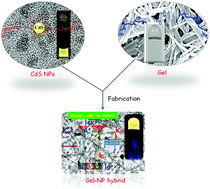Hierarchical self-assembly of photoluminescent CdS nanoparticles into a bile acid derived organogel: morphological and photophysical properties†
Abstract
We have described a strategy towards integrating photoluminescent semiconductor nanoparticles into a bio-surfactant derived organogel. A facially amphiphilic bile thiol was used for capping CdS nanoparticles (NPs) which were embedded in a bile acid derived new organogelator in order to furnish a soft hybrid material. The presence of CdS NPs in a well-ordered 1D array on the organogel network was confirmed using microscopic techniques. Photophysical studies of the gel–NP hybrid revealed resolved excitation and emission characteristics. Time resolved spectroscopic studies showed that the average lifetime value of the CdS NPs increased in the gel state compared to the sol phase. A kinetic model was utilized to obtain quantitative information about the different decay pathways of the photoexcited NPs in the sol and gel states.



 Please wait while we load your content...
Please wait while we load your content...